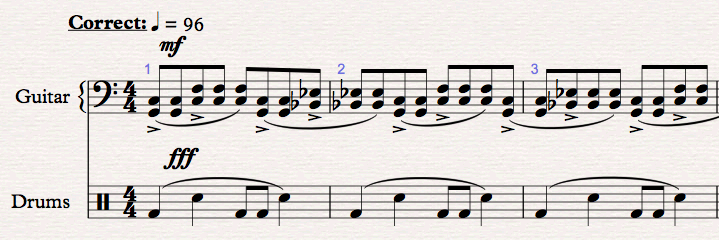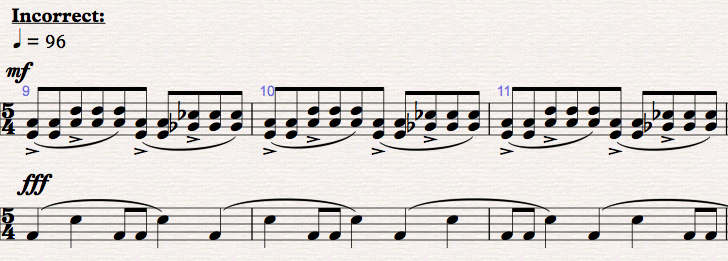
+ Welcome to Soundfly! We help curious musicians meet their goals with creative online courses. Whatever you want to learn, whenever you need to learn it. Subscribe now to start learning on the ’Fly.
If a music lover happens to be a fan of both technically complex music, and popular genres like rap, electro, hip-hop, and dance EDM, then the Gorillaz’ 2001 self-titled, debut album will be an endless source of deep musical enjoyment. Boring synths devoid of all expressive personality in the form of monotonously tedious 4-bar structures are pretty much ignored, in favor of musical textures and songs that re-invent themselves between each and every single bar.
A particularly glowing example of this is the second track on the album, a song that is likely a major reason why the “creator” of the Gorillaz, Damon Albarn, has earned several Grammy nominations. To begin with, the title of the song — “5/4” — is a reference to the song’s meter… But is it? That questioning qualifier is important, as we’ll see after a quick look into this song’s music theory. First, listen to the track and see if you can tell what’s going on with the time signature:
+ Read more on Flypaper: “4 Tips to Help You Start Writing in Irregular Time Signatures”
The chord progression vs. the rhythm pattern
For a pop song to have a meter of 5/4, of which there are very few examples, would mean that every measure has five quarter notes inside of it. The feel of such a meter is essentially unbalanced, because there is an uneven number of quarter notes in the song. This would stand in strong contrast to the usual meter of almost every other pop song out there. And when “5/4” begins, the song actually does appear to be in this complex meter.
To start the song off, a rickety, grizzled electric guitar hammers out hard double stops in a bluesy, flattened key whose chords are grouped together into repetitions of five 8th notes. The entire chord progression starts over only after that group of five 8th notes has been played two full times. As long as there are no drums, the title of the song fits the musical situation perfectly.
But then the drums come in. We hear the snare drum and bass kick work together in an unexpectedly normal, straightforward way. The drums are, in contrast to the guitar, playing a straight, 4/4 meter. The bass kick of the set plays on the first and third quarter notes of a possible 4/4 meter, while the snare plays right on top of the second and fourth quarter notes of that same 4/4 meter. Because the dominant feature of the musical texture, the drums, fits into a meter that is much more common, this song maybe should have been called “4/4” instead of “5/4.” While the meter so far seems up for question, the dynamic level of each respective group of instruments — drums and guitar — is not.
The drums are much, much louder than the guitars. With a bumpier low end, and a sharper high end, the drums dominate the mix. Because of this, any interpretation of the music as a whole should rely on first figuring out what the drums are doing, rather than what the guitar is doing, which is how a misnaming like “5/4” would occur in the first place. For these very reasons of orchestration, dynamic level, rhythm, meter, performability, and stereophonic mixing, 4/4 is a much better meter for this song to be notated in, rather than the titular 5/4.

Is it worth changing, though?
Laying down a 5/4 rhythm in the drum pattern would solve the consistency issue, but it wouldn’t necessarily make the song sound better… Let’s look at why a 5/4 interpretation could actually come with some undesired musical implications in either the studio recording or a performance context.
To see just how incorrect a 5/4 interpretation is, take a look at what the transcription of this song in 5/4 would be for the drummer. This sheet music would require the drummer to treat each of the five quarter notes in the meter as having a strong accent at one moment, and then a weak accent in the very next bar. This is the opposite of what transcriptions are supposed to do, which is to make music easier to play. Playing rhythms that constantly shift their accent in this extreme way is one of the hardest things any instrumentalist can ever be asked to do. While a guitarist would be asked to change their accents in 4/4, the guitarist is responsible only for guiding themselves; the drummer directs both the other instruments and the general motion of the song.
+ Read more on Flypaper: “The Ins and Outs of Recording Your Guitar ‘Direct In’”

In contrast, there is another song on this album that, although structured similarly, does not fall into the same trap as “5/4.” In “New Genius (Brother),” Albarn’s stereophonic production complicates the overall meter of the song, without confusing it. In other words, it does not try to fit a 3/4 pattern into a 4/4 box.
The cymbal hits (which sound a bit like metal bowls) that open this track at a quiet, pianissimo level in the far right corner of the stereo spectrum, are actually playing in 3/4. The drummer (or sample) plays each of his three tuned cymbals just once for a single quarter note, in repetition. As a result, a musical idea whose length — three quarter notes — is out of step with the meter’s four has been sent to the back of the musical picture via panning.
The same type of musical trickery (making use of the production techniques of stereo mixing, dynamic level, and timbre) is at work just as brilliantly in “New Genius (Brother)” as it is in “5/4.” In both cases, Albarn uses a stable meter to keep the songs accessible, while integrating an off-meter element to keep things interesting. But in the “New Genius,” Albarn didn’t name the song after the incorrect time signature…
To recap, “5/4” isn’t in 5/4 time because the drums are deciding the meter, not the guitar part. The guitar part, instead, is changing its starting rhythmic position several times over the top of the 4/4 structure of the bar, but not changing the structure of the bar itself.
Even if the song’s musicians are thinking in complex groupings of 5, they are playing in more straightforward groupings of 4. The following audio clip is a rough rendering of what a version of “5/4” that’s actually in a 5/4 meter might sound like, with the guitars played louder and the drums’ role made smaller:
You can’t say Damon Albarn doesn’t know what the heck he’s talking about. This is theory and mixing production working hand in hand, and music is pretty darn complicated. To decide what a piece of music is doing at any point in time relies not just on describing the piece’s meter, or its orchestration, or its harmony, melody, dynamics, or anything else, but how they all work together.
At the end of the day, though, any fan of incredibly original music should never want to be the one to tell a Grammy-nominated artist to rename one of his best songs from “5/4” to “A 5-8th Note Rhythmic Phrase Repeated Twice Over a 4/4 Metric Backbeat.” If such creativity comes at the cost of music theory education, then that is probably more than an even trade-off.
Want to get all of Soundfly’s premium online courses for a low monthly cost?
Subscribe to get unlimited access to all of our course content, an invitation to join our members-only Slack community forum, exclusive perks from partner brands, and massive discounts on personalized mentor sessions for guided learning. Learn what you want, whenever you want, with total freedom.




